Production ag has always been the lifeblood of equipment dealerships, but about a decade ago, a new segment was gaining attention among dealers, manufacturers and the ag journalists at Lessiter Publications (now Lessiter Media).
“We had acquired Farm Equipment magazine in 2004 and it wasn’t long after that dealers began talking with Dave Kanicki and me about this ‘hobby farmer’ customer. We were tuning in that this customer was becoming very important and also very different from the rest of their customer base,” says Mike Lessiter, president of Lessiter Media, publishers of Rural Lifestyle Dealer and Farm Equipment magazines. Dave Kanicki is executive editor of both magazines.
“While the ‘tried and true’ farm equipment salesperson was used to dealing with farmers who were very knowledgeable about equipment and their needs, as the rural landscape changed, all kinds of people were moving to the country and buying small acreages.
“Dealers were faced with a different kind of customer who needed more of a retail experience. And because farm equipment dealers were better funded and more established in their communities, manufacturers of equipment saw a lot of advantages over other models. These operations had staying power and manufacturers got behind that in a hurry,” Lessiter recalls, citing the reception exhibitors at the Green Industry & Equipment Expo (GIE+Expo) gave him and his staff who were wearing Farm Equipment shirts at an early show.
Dealers needed specific and practical information on the hobby farmer that Lessiter says couldn’t be properly covered through the pages of Farm Equipment alone. And he and Kanicki were seeing that it deserved a focused media of its own.

|
| Mike Lessiter (left) is president of Lessiter Media, which launched Rural Lifestyle Dealer in 2007. Michael Ellis has been publisher since 2010. Both say the rural equipment market offers many advantages to dealers, including buyers who seek out their expertise and a way to balance the ups and downs of the production ag market. The market base also continues to grow, bringing in new customers. |
Manufacturers also recognized their dealers needed new approaches if they were to succeed in the market. One executive shared in a May 2007 memo on the launch, “There’s a real need for a magazine like this. Rural lifestyle dealers get very little in the way of support, training aids and information about what’s going on in the market. There is lots of potential for growth in the rural lifestyle segment.”
Another executive stressed his excitement about the magazine creating greater respect for this kind of customer. And the dealer, he said, can be very profitable in this market. “They’re excited about tractors and will pay retail prices. They’ll gladly pay your service rates. They don’t have a shop or tools and many can’t fix anything.”
To answer this need, Rural Lifestyle Dealer was launched in the fall of 2007 as a twice-a-year supplement to Farm Equipment magazine. The magazine quickly gained traction, becoming a quarterly in 2009. The brand has since grown to become a stand-alone magazine with a dedicated website, daily email news updates, twice-monthly eBrief newsletters, interactive digital editions, webinars and more.
“Even those dealers who think of themselves as serving professional farmers also sell lots of rural lifestyle equipment. And because the market is not driven by commodity prices, it can offer dealers diversification,” Lessiter says.
Still Evolving Market
Michael Ellis has been publisher of Rural Lifestyle Dealer since 2010. He says the segment had tremendous revenue potential from the start. “Back in 2009, we shared stats regarding the buying power of the segment — $32 billion — from the 69 million people living in the rural U.S. That’s a lot of money that can be made by dealers who are willing to make the investments necessary to serve the segment right,” says Ellis.
“The rural lifestyle market is much more than a niche…”
Sharing Lessiter’s view about respect for the market, Ellis says that in the early days of the magazine, they kept hearing the same themes from rural lifestylers. “Customers would share stories about coming in and being dismissed by salespeople because they weren’t knowledgeable about the equipment. They would eventually find a dealer who respected them and that dealer would have their business for years to come,” he says.
Part of the problem was that dealers didn’t understand how the market fit with their traditional customers. “Many were still unsure of how the segment fit with the ag world and the power equipment world and didn’t understand the strength that exists between those worlds,” Ellis says.
A change was in the works, though, with progressive dealers changing their attitudes and sales strategies.
“Dealers were beginning to create a balance in their business model between the production ag and rural lifestyle markets. Dealers could have a foothold in the ag world and still make money in the rural lifestyle market, especially during times like we’re experiencing now when revenue from production ag is down 20% and more,” Ellis says.
Adapting Strategies
Dealer TakeawaysDealers can find success focusing exclusively on the rural equipment market or balancing it with selling to the ag sector. Respecting the rural lifestyle customer, regardless of their level of equipment expertise, can build long-term relationships. New models of equipment incorporate higher levels of technology and additional comfort features. Both enhancements give dealers and customers more reasons to be excited about the offerings. |
Dealers who have success in the market, then and now, understand the differences in selling to rural lifestylers. “They can be a harder sell because they need more hand-holding, even as they become more knowledgeable and sophisticated about the equipment,” Ellis says.
They also expect more in terms of the buying experience. “Some of the big ag dealerships could get away with being messy, because, for the most part, farmers didn’t care. Over the years, rural lifestyle dealerships took the best of the car buying experience. They’ve made leaps in their presentations of their dealerships, the presentations of their equipment and packages, and in the presentation of themselves as the dealer principals,” he says.
Online branding and functionality continues to increase in importance in reaching customers. Early on, some dealers would rely on just being included in an online yellow pages-type directory or dealer listings on manufacturer websites. Today, progressive dealers have responsive websites, are active on social media and use multi-media approaches to reach rural lifestylers.
“If a dealer is not current with the latest in marketing techniques, customers are going to wonder if they are in it for the long haul,” Ellis says.
Support from Manufacturers
Manufacturers are finding new ways to attract first-time buyers and follow-on sales for their dealers, with the latest innovations focusing on operator comfort and ergonomics.
What Does Rural Lifestyle Mean?Rural Lifestyle Dealer has been answering that question for 10 years — and the answer is complex. That’s a good thing because it means the market is diverse, encompassing small acreage farmers, hobby farmers, commercial landscapers, light construction contractors, municipalities, arborists, golf course superintendents, homeowners and production farmers. The rural lifestyle market is the “sweet spot” among several overlapping customer segments. (View chart below.] That diversity also means dealers need to develop a broad base of knowledge and expertise about the equipment they sell and service as well as watch for trends and opportunities in the market. The Rural Lifestyle Dealer editorial team voted on the best covers since the magazine was launched that help answer the question, “What does rural lifestyle mean?” as well as the follow-up question: “How can I achieve success in selling and servicing this market?” Take a look.
|
“It was apparent at GIE+Expo this year that manufacturers are giving a lot of attention to creature comforts. They’re offering floating decks, suspension seats and slicker designs — moving beyond the ‘industrial’ designs of the past. We, as consumers, are spoiled and want equipment that’s ‘cushy.’ Our market is evolving to offer that experience whether it’s through mowing, driving a tractor or running a skid steer,” Ellis says.
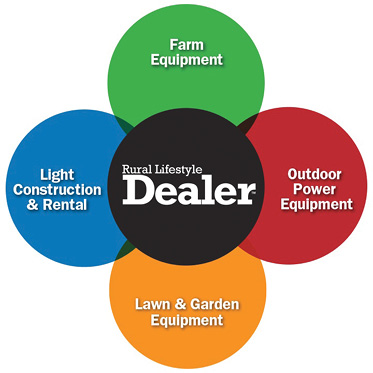
|
| The rural lifestyle market is the “sweet spot” among several overlapping customer segments. The market’s diversity keeps it strong year-round and year-over-year. |
Creating More Success
As the rural equipment market continues to evolve, Ellis says that each dealer has to define what success means for them. For some, it can be multiple locations, but single-store dealerships have also stood out as the best of the best and have recently been recognized as Rural Lifestyle Dealer Dealerships of the Year.
“It’s more about a commitment to excellence and a respect for what serving this segment can mean for long-term viability. I don’t think anybody in this business should think in terms of only serving a niche market. The rural lifestyle market is much more than that,” Ellis says.
“Manufacturers, dealers and our magazine are all in a good place now and we need to make the most of these opportunities. Our version of ‘staying the course’ at the magazine is to constantly look for ways to evolve so that we continue to deliver valuable content that helps dealers be more successful,” says Ellis.
“Some might wonder how much more can be done with compact tractors or zero turns, but manufacturers continue to tweak the offerings. And new companies are still entering the market.”
“There have been two or three significant entries into the zero-turn market just in the last few years, during a time when many thought the segment was saturated. This shows that opportunities are still out there and pushes the industry to work harder and find new ways to innovate,” he says. Rural lifestyle applications for precision technology could be the next phase of innovation.


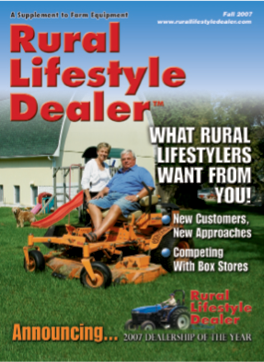
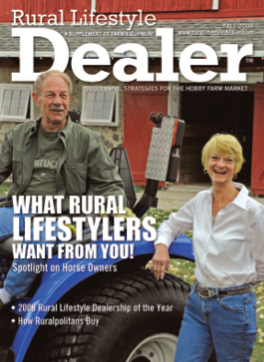
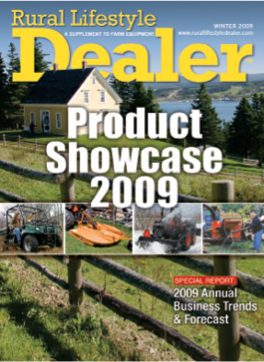
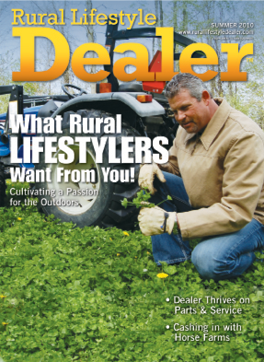

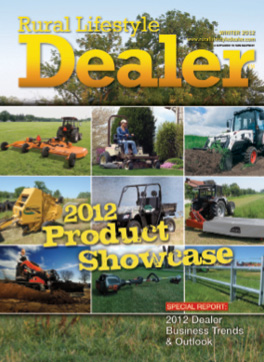
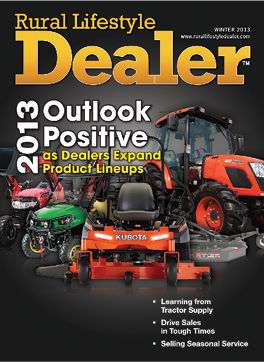
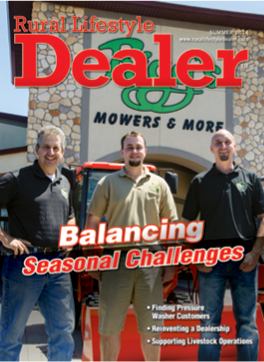
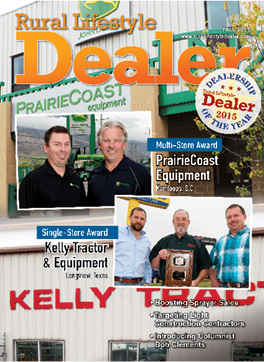




Post a comment
Report Abusive Comment